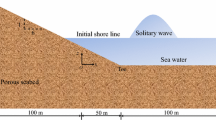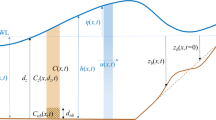Abstract
Wave propagation on uniformly sloped beaches is a canonical coastal engineering topic that has been studied extensively in the past few decades. However, most of these studies treat beaches as solid boundaries even though they are often made of porous materials, such as sediment and vegetation. Permeable beaches struck by tsunami-like waves have not been adequately investigated. It is expected that the degree of permeability plays a crucial role in mitigating the impact of the wave. This study examines solitary wave run-ups on sandy beaches using an incompressible smoothed particle hydrodynamics (ISPH) model. The permeability of the beach is considered to be directly related to the diameter of its constituent sand particles. To obtain a satisfactory pressure field, which cannot be achieved using the original ISPH algorithm, the source term of the pressure Poisson equation has been modified based on a higher-order source-term expression. Flows within the porous medium are computed in the same framework as those outside the porous medium. In the current model, no transition zone is needed at the boundary of the porous structure. The wave-attenuation effect of the porous medium is discussed, with a particular focus on the relationship between the run-up height and grainsize.
Similar content being viewed by others
References
Yeh H., Francis M., Peterson C. et al. Effects of the 2004 great Sumatra tsunami: Southeast Indian coast [J]. Journal of Waterway, Port, Coastal, and Ocean Engineering, 2007, 133(6): 382–400.
Ebersole B. A., Westerink J. J., Bunya S. et al. Development of storm surge which led to flooding in St. Bernard Polder during Hurricane Katrina [J]. Ocean Engineering, 2010, 37(1): 91–103.
Tsuchiya M. Hydraulic test on a combined body with tidal forest and wave dissipating works in order to reduce tsunami force [J]. JSNDS, 2013, 32(3): 249–259.
Synolakis C. E. The runup of long waves [D]. Doctoral Thesis, Pasadena, CA, USA: California Institute of Technology, 1986.
Synolakis C. E. The runup of solitary waves [J]. Journal of Fluid Mechanics, 1987, 185: 523–545.
Hughes S. A. Estimation of wave run-up on smooth, impermeable slopes using the wave momentum flux parameter [J]. Coastal Engineering, 2004, 51(11–12): 1085–1104.
Li Y., Raichlen, F. Solitary wave runup on plane slopes [J]. Journal of Waterway, Port, Coastal, and Ocean Engineering, 2001, 127(1): 33–44.
Chang Y. H., Hwang K. S., Hwung H. H. Large-scale laboratory measurements of solitary wave inundation on a 1: 20 slope [J]. Coastal Engineering, 2009, 56(10): 1022–1034.
Liang D., Gotoh H., Khayyer A. et al. Boussinesq modelling of solitary wave and N-wave runup on coast [J]. Applied Ocean Research, 2013, 42: 144–154.
Liang D., Liu H., Tang H. et al. Comparison between Boussinesq and shallow-water models in predicting solitary wave runup on plane beaches [J]. Coastal Engineering Journal, 2013, 55(4): 1350014
Khayyer A., Gotoh H., Shao S. Enhanced predictions of wave impact pressure by improved incompressible SPH methods [J]. Applied Ocean Research, 2009, 31(2): 111–131.
Asai M., Aly A. M., Sonoda Y. et al. A stabilized incompressible SPH method by relaxing the density invariance condition [J]. Journal of Applied Mathematics, 2012, ID139583.
Gui Q., Dong P., Shao S. Numerical study of PPE source term errors in the incompressible SPH models [J]. International Journal for Numerical Methods in Fluids, 2015, 77(6): 358–379.
Ren B., Wen H., Dong P. et al. Improved SPH simulation of wave motions and turbulent flows through porous media [J]. Coastal Engineering, 2016, 107: 14–27.
Liang D., He X., Zhang J. X. An ISPH model for flow-like landslides and interaction with structures [J]. Journal of Hydrodynamics, 2017, 29(5): 894–897.
Peng C., Xu G., Wu W. et al. Multiphase SPH modeling of free surface flow in porous media with variable porosity [J]. Computers and Geotechnics, 2017, 81: 239–248.
Akbari H. Modified moving particle method for modeling wave interaction with multi layered porous structures [J]. Coastal Engineering, 2014, 89: 1–19.
Khayyer A., Gotoh H., Falahaty H. et al. Towards development of enhanced fully-Lagrangian mesh-free computational methods for fluid-structure interaction [J]. Journal of Hydrodynamics, 2018, 30(1): 49–61.
Koh C. G., Luo M., Gao M. et al. Modelling of liquid sloshing with constrained floating baffle [J]. Computers and Structures, 2013, 122: 270–279.
Goring D. G. Tsunamis-the propagation of long waves onto a shelf [D]. Doctoral Thesis, Pasadena, CA, USA: California Institute of Technology, 1978.
Liu P. L. F., Lin P., Chang K. A. et al. Numerical modeling of wave interaction with porous structures [J]. Journal of Waterway, Port, Coastal, and Ocean Engineering, 1999, 125(6): 322–330.
Acknowledgements
This work was supported by the Royal Academy of Engineering UK-China Urban Flooding Research Impact Programme (Grant No. UUFRIP100051), the Ministry of Education and State Administration of Foreign Experts Affairs 111 Project (Grant No. B17015) and the Cambridge Tier-2 system operated by the University of Cambridge Research Computing Service (http://www.hpc.cam.ac.uk) funded by EPSRC Tier-2 capital (Grant No. EP/P020259/1).
Author information
Authors and Affiliations
Corresponding author
Additional information
Biography: Chiaki Tsurudome (1991-), Female, Ph. D.
Rights and permissions
About this article
Cite this article
Tsurudome, C., Liang, D., Shimizu, Y. et al. Incompressible SPH simulation of solitary wave propagation on permeable beaches. J Hydrodyn 32, 664–671 (2020). https://doi.org/10.1007/s42241-020-0042-0
Received:
Revised:
Accepted:
Published:
Issue Date:
DOI: https://doi.org/10.1007/s42241-020-0042-0




